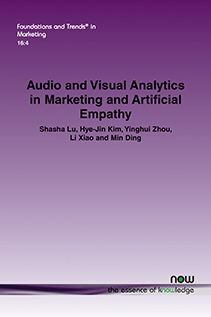Audio and Visual Analytics in Marketing and Artificial Empathy
By Shasha Lu, University of Cambridge, UK, s.lu@jbs.cam.ac.uk | Hye-Jin Kim, Korea Advanced Institute of Science and Technology (KAIST), South Korea, hyejinkim@kaist.ac.kr | Yinghui Zhou, Shenzhen University, China, yhzhou@szu.edu.cn | Li Xiao, Fudan University, China, lixiao@fudan.edu.cn | Min Ding, Pennsylvania State University, USA, minding@psu.edu
Abstract
With the ever-cheaper digital equipment and the prevalent digital platforms such as Facebook and YouTube, more and more human behaviors and activities are digitalized in the form of images, videos, and audio. However, due to the information’s unstructured nature, there has been a lack of useful framework and tools that can help businesses to effectively leverage this information to improve their practices. As a result, businesses are missing out on the opportunities to use this information to gain better customer insights, understand customer preference, improve customer experience, discover unmet needs and optimize marketing effectiveness. In this monograph, the authors present an overview of audio and visual analytics and discuss how they can be used by marketers to improve business practices. This monograph first introduced a framework named Artificial Empathy (AE) to illustrate different contexts where the audio and/or visual information emitted by or presented to an individual are used to improve business decision making. Next, it presented a review of the cutting-edge techniques and methods used to mine valuable information and make useful inferences from the audio and visual data. Finally, it reviewed the use of A/V analytics in business practices and concluded with a discussion on the trends in applying audio and visual data analytics in business. This monograph aims to help readers understand how the new forms of rich data will affect the way we do business and gain insights into harnessing the power of audio, image, and video data to make useful inferences and improve business practices.
Audio and Visual Analytics in Marketing and Artificial Empathy
Audio and Visual Analytics in Marketing addresses questions around the application and use of audio/visual data analytics for business decision making in the post-digital economy. It does so by: (1) developing a framework for understanding the internal states of individuals based on audio/visual signals and incorporating works in the domain of audio/visual (A/V) data analytics into marketing research in order to identify future research opportunities; (2) providing an overview of methodologies that are commonly used in conducting research with A/V data; (3) providing a review of A/V analytics-based research in various business contexts; and (4) reviewing the business practices using A/V analytics and identifying the future trends in both research and business applications.
The rest of the monograph is organized as follows: The authors first propose a framework for A/V data-based research in the business domain and discuss how A/V data analytics can be used to support business decision making in various contexts. They then provide an overview of the key techniques and tools used in A/V data analytics and discuss the procedures and key methodological questions. Finally, they discuss how the A/V analytics has been used in business practices and its trend and future development.
